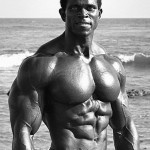Measuring muscle growth and fat loss isn’t as easy as stepping on the scale although this seems to be the default way most people try to do it.
The look of your body is determined by fat mass, muscle mass and water. But this isn’t as straight forward as you might think.
Body Fat Storage Patterns
Fat mass is not stored uniformly around your body, and there is a storage rate and burn patter to your fat as well. In other words some places store more fat than others (ie: Belly) and some places burn fat slower than others (ie: Belly).
We know that on a mans body, fat tends to store faster and to a higher degree in the abdomen area viscera (underneath your abs around your intestines and organs). The visceral fat actually burns quickly and this is part of the reason why your waist measurement can decrease dramatically without your abs becoming visible right away.
This fat that is above your abs is what most people refer to as ‘stubborn fat’. In reality this fat doesn’t have a bad attitude and is no more ‘stubborn’ than your shoes (I don’t know why people try to give fat a personality like this). The fat covering your abs has a lower blood supply and less fat mobilizing receptors than other fat compartments in your body, this means it takes longer for this fat to be completely burned off compared to other areas…hence the reason why your abs are the last thing to show when you’re dieting down.
This doesn’t mean you can’t get rid of this fat, it just means that it’ll be the last place you’ll finally see definition, and it’s likely not going to correlate with pounds lost on the scale when you get to your leanest look.
Measuring Muscle Growth
For experienced lifters muscle growth is also difficult to measure with a scale. Daily fluctuations in body weight can easily mask any short term change in muscle mass. The size of a muscle is somewhat transient and true changes in it’s size require longer term measurement intervals to truly track changes (6-12 months).
Measuring circumferences is a much better and more accurate way to measure changes in muscle growth compared to the scale, at least this way you have proof of where the size/muscle really is.
Measuring Fat Loss and Muscle Building Progress
Measuring both muscle building and fat loss progress at the same time is virtually impossible on a scale as you can do both with no change in your bodyweight.
Since bodyweight simply cannot tell you much about your short term changes in fat or muscle mass a new and better metric is necessary…enter the Muscle Index.
As we talked about last week the Muscle Index is a way of measuring how muscular your body is withing relying on the scale and correcting for gains in weight due to fat or extracellular water weight.
In other words, if you gain 10lbs, but it’s all from fat, water and thanksgiving dinner the muscle index calculation won’t lie, but the scale will.
In todays podcast I recruit the help of a good friend Bryan Chung. Bryan is a plastic surgeon resident and has his PhD in sports medicine. You can read is critical review of fitness research at his blog: http://www.evidencebasedfitness.blogspot.com/
We discuss how hard it really is for the average person to guess how much bodyfat they have and what they assume their body should weigh when they’re ‘in shape’. We also talk about the uneven fat distribution patterns of men and women and why relying too much on the scale can play mind games with you and derail your progress.
John
Podcast: Play in new window | Download
